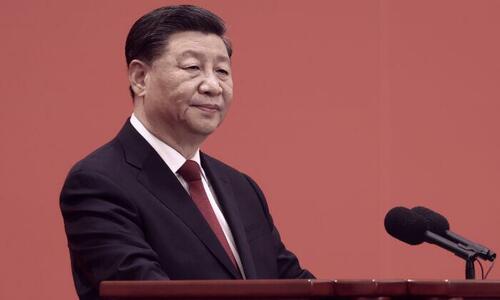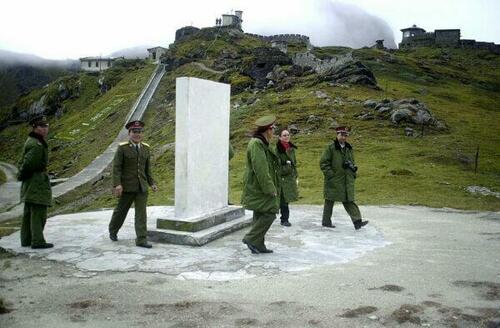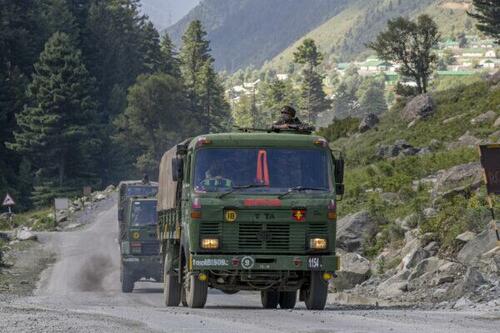
Authored by Stu Cvrk via The Epoch Times,
For months, China watchers have been focused like laser beams on the Taiwan Strait, with much speculation on whether and when communist China will attempt a cross-Strait invasion to “absorb” Taiwan by force into the “People’s Republic.”
That speculation became a fever pitch due to two events: Nancy Pelosi’s 19-hour visit to Taipei back in July and Chinese leader Xi Jinping’s triumphant report to the Chinese Communist Party’s 20th National Congress in October.
The first event led to a surge in People’s Liberation Army (PLA) intimidation of Taiwan, while the second reemphasized “unification” as “a natural requirement for realizing the rejuvenation of the Chinese nation” to be achieved by the hundred-year anniversary of the founding of the Chinese communist dictatorship.
Will Xi pull the trigger, or won’t he? And when might that happen? Within the next year or perhaps by 2027? The opinions are all over the map.
Xi elevated himself to Mao Zedong-level status by receiving an unprecedented third five-year term as general secretary of the CCP and chairman of the Central Military Commission. The 20th Congress was a complete triumph for Xi: the constitution was modified to essentially allow him to be “emperor for life,” his allies filled all important positions in the new Standing Politburo, and former leader Hu Jintao was humiliated and frog-marched out of the plenary session by Xi’s thugs.
Furthermore, the Congress did not designate a successor to Xi. And the cult of Xi is advanced daily by state-run Chinese media in the same way they propagandized that Mao could do no wrong during his cruel reign.
Xi’s rhetoric about “peaceful unification with Taiwan” is meaningless, as reunification will be accomplished at the end of the PLA’s bayonets unless Taiwan and its allies surrender. With the continued modernization and growth of the PLA and PLA Navy, Taiwan watchers are rightfully concerned that Xi has completely consolidated political power and has the means and will to use the Chinese military to achieve his stated goals, including “reunification.”
And Xi is not afraid to use authoritarian methods to achieve his goals, as the last 10 years have shown: reeducation camps in Xinjiang, increased persecution of minority populations and religious groups, arbitrary and brutal zero-COVID lockdowns, and outright genocide against Uyghurs and others, including Tibetans.
Speaking of Tibet, could territorial gains in South China be a more immediate goal for Xi than the absorption of Taiwan?
After all, PLA ground forces have a record of success in capturing and occupying territory. In contrast, the PLA Navy is untested and faces logistics hurdles in supporting and sustaining a cross-Strait invasion.
China’s aircraft carrier Liaoning takes part in a military drill of the Chinese People’s Liberation Army (PLA) Navy in the western Pacific Ocean on April 18, 2018. (Reuters)
Mao left some unfinished business after the PLA invaded Tibet in 1949. After defeating the small Tibetan army and occupying the country, the communists imposed the sham “17-Point Agreement for the Peaceful Liberation of Tibet” on the Tibetan government in 1951. The communists annexed Tibet and began the genocide and pacification efforts that continue today, including torture, suppression of Tibetan culture, forced imprisonment and “reeducation,” and other brutality. Over a million Tibetans perished, and more than 6,000 monasteries were looted and razed as the CCP systematically destroyed Tibet’s ancient Buddhist civilization. The Dalai Lama and thousands of his followers subsequently fled to India in 1959 and established a government in exile.
Five Fingers Policy
The Chinese communists’ actions in Tibet were part of a long-expressed foreign policy developed by Mao during the 1940s—the so-called “Five Fingers Policy.” The essence of the policy is this: “While Tibet was the right hand of China, Sikkim, Arunachal Pradesh, Bhutan, Nepal, and Ladakh were its ‘five fingers’ of its periphery and that it was China’s duty to ‘liberate’ these areas,” according to India-based education tech company Byju’s. Never mind the wishes and dreams of the peaceful inhabitants of these areas!
The policy, of course, was nothing but a bald-faced characterization of communist China’s expansionist goals in the region, which could only be achieved at the expense of India—the Seven Sister States of northeast India (Arunachal Pradesh, Assam, Meghalaya, Manipur, Mizoram, Nagaland, and Tripura), Sikkim, the Siliguri Corridor, Utter Pradesh, and the western states of Jammu and Kashmir, Himachal Pradesh, and Uttar Pradesh. Previously quasi-independent, Sikkim joined the rest of India as a state in 1975—probably as much in fear of the Chinese communists as anything. These are all on the Indian side of the Line of Actual Control (LAC), a disputed demarcation that separates Indian-controlled territory from Chinese-controlled territory.
Chinese soldiers are pictured at the Nathu La Pass area at the India-China border in the north-eastern Indian state of Sikkim in August 2003. The two sides had a minor face-off at another pass called the Naku La on Jan. 20, 2021, according to the Indian army. (STR/AFP via Getty Images)
The PLA and the Indian Army have crossed swords in various military skirmishes and a border war in 1962 over LAC disputes. Here are some of those confrontations:
-
The 1962 Sino-Indian Border War, which killed 8,000 Indians and 2,000 Chinese, resulted in the establishment of a 12-mile-wide demilitarized zone along the LAC.
-
Nathu La and Cho La skirmishes near Sikkim in 1967 over India’s construction of an iron fence to prevent Chinese incursions.
-
The Tulung La Incident in 1975 along the LAC in Arunachal Pradesh.
-
The Sumdorong Chu Valley standoff in 1987 after India granted statehood to Arunachal Pradesh (claimed by China as “South Tibet”).
-
The Daulat Beg Oldi and Chumar standoffs in 2013 over the construction of various structures and encampments.
-
The Demchok standoff in 2014 over reciprocal claims of “illegal construction” in disputed areas.
-
The Burtse incident in 2015 in which India destroyed a watchtower that was “too close” to the mutually agreed-upon patrolling lane.
-
The Doklam standoff in 2017 after China began building a road through southern Bhutan that threatened the Siliguri Corridor.
-
The Sino-Indian skirmishes in 2020 near Pangong Tso Lake and the Galwan Valley in Ladakh. Beijing subsequently asserted sovereignty over the entire Galwan Valley, representing a significant change to the status quo in the western part of the LAC. During this incident, “dozens of Indian and Chinese soldiers died beating each other with sticks, clubs, and other rudimentary weapons,” Breitbart reported.
-
The 2022 standoff in Arunachal Pradesh state over a Chinese village.
And now there have been multiple reports of Indian and Chinese troops clashing on the border at the Tawang sector in the Indian state of Arunachal Pradesh on Dec. 9. “PLA troops crossed the LAC in the Tawang sector, which was contested by [India’s] own troops in a firm and resolute manner. This face-off led to minor injuries to a few personnel from both sides,” according to an Indian army spokesman.
An Indian army convoy moves on the Srinagar-Ladakh highway at Gagangeer, northeast of Srinagar, Indian-controlled Kashmir, on Sept. 9, 2020. (Dar Yasin/AP Photo)
While Mao’s “Five Fingers Policy” seemed to have died with him—as there have been no public utterances of it by subsequent Chinese leaders and diplomats since Mao’s passing—it is entirely possible that Xi has resurrected the policy, given that the preponderance of China-India skirmishes along the LAC has occurred during his tenure (and seem to be accelerating in frequency).
Concluding Thoughts
Xi has elevated himself to the stature of Mao, at least on the political level. To transcend Mao in the eyes of the CCP cadre and the Chinese people, in general, may be his ultimate personal goal. Mao left two major policies unfulfilled: the annexation of the Five Fingers and unification with Taiwan. To achieve either or both would cement Xi’s claim to be at least the equal of Mao by finishing what the Great Helmsman himself could not do.
Xi claims to have read various Western authors, including Alexander Pushkin, Leo Tolstoy, Johann Wolfgang von Goethe (Faust), Walt Whitman, Mark Twain, Jack London, Ernest Hemingway, and Victor Hugo, according to CCP mouthpiece People’s Daily. Such claims undoubtedly help cement the cult of Xi in the minds of many.
Has the apparently well-read Xi partaken of any books from ancient Greece? If so, perhaps he understands the concept of the alpha and the omega—the beginning and the end. God-willing, Mao was the alpha of the Chinese communist regime, and Xi is the omega.
Keep your eyes on Tibet and India’s Seven Sisters in the meantime.
Authored by Stu Cvrk via The Epoch Times,
For months, China watchers have been focused like laser beams on the Taiwan Strait, with much speculation on whether and when communist China will attempt a cross-Strait invasion to “absorb” Taiwan by force into the “People’s Republic.”
That speculation became a fever pitch due to two events: Nancy Pelosi’s 19-hour visit to Taipei back in July and Chinese leader Xi Jinping’s triumphant report to the Chinese Communist Party’s 20th National Congress in October.
The first event led to a surge in People’s Liberation Army (PLA) intimidation of Taiwan, while the second reemphasized “unification” as “a natural requirement for realizing the rejuvenation of the Chinese nation” to be achieved by the hundred-year anniversary of the founding of the Chinese communist dictatorship.
Will Xi pull the trigger, or won’t he? And when might that happen? Within the next year or perhaps by 2027? The opinions are all over the map.
Xi elevated himself to Mao Zedong-level status by receiving an unprecedented third five-year term as general secretary of the CCP and chairman of the Central Military Commission. The 20th Congress was a complete triumph for Xi: the constitution was modified to essentially allow him to be “emperor for life,” his allies filled all important positions in the new Standing Politburo, and former leader Hu Jintao was humiliated and frog-marched out of the plenary session by Xi’s thugs.
Furthermore, the Congress did not designate a successor to Xi. And the cult of Xi is advanced daily by state-run Chinese media in the same way they propagandized that Mao could do no wrong during his cruel reign.
Xi’s rhetoric about “peaceful unification with Taiwan” is meaningless, as reunification will be accomplished at the end of the PLA’s bayonets unless Taiwan and its allies surrender. With the continued modernization and growth of the PLA and PLA Navy, Taiwan watchers are rightfully concerned that Xi has completely consolidated political power and has the means and will to use the Chinese military to achieve his stated goals, including “reunification.”
And Xi is not afraid to use authoritarian methods to achieve his goals, as the last 10 years have shown: reeducation camps in Xinjiang, increased persecution of minority populations and religious groups, arbitrary and brutal zero-COVID lockdowns, and outright genocide against Uyghurs and others, including Tibetans.
Speaking of Tibet, could territorial gains in South China be a more immediate goal for Xi than the absorption of Taiwan?
After all, PLA ground forces have a record of success in capturing and occupying territory. In contrast, the PLA Navy is untested and faces logistics hurdles in supporting and sustaining a cross-Strait invasion.
China’s aircraft carrier Liaoning takes part in a military drill of the Chinese People’s Liberation Army (PLA) Navy in the western Pacific Ocean on April 18, 2018. (Reuters)
Mao left some unfinished business after the PLA invaded Tibet in 1949. After defeating the small Tibetan army and occupying the country, the communists imposed the sham “17-Point Agreement for the Peaceful Liberation of Tibet” on the Tibetan government in 1951. The communists annexed Tibet and began the genocide and pacification efforts that continue today, including torture, suppression of Tibetan culture, forced imprisonment and “reeducation,” and other brutality. Over a million Tibetans perished, and more than 6,000 monasteries were looted and razed as the CCP systematically destroyed Tibet’s ancient Buddhist civilization. The Dalai Lama and thousands of his followers subsequently fled to India in 1959 and established a government in exile.
Five Fingers Policy
The Chinese communists’ actions in Tibet were part of a long-expressed foreign policy developed by Mao during the 1940s—the so-called “Five Fingers Policy.” The essence of the policy is this: “While Tibet was the right hand of China, Sikkim, Arunachal Pradesh, Bhutan, Nepal, and Ladakh were its ‘five fingers’ of its periphery and that it was China’s duty to ‘liberate’ these areas,” according to India-based education tech company Byju’s. Never mind the wishes and dreams of the peaceful inhabitants of these areas!
The policy, of course, was nothing but a bald-faced characterization of communist China’s expansionist goals in the region, which could only be achieved at the expense of India—the Seven Sister States of northeast India (Arunachal Pradesh, Assam, Meghalaya, Manipur, Mizoram, Nagaland, and Tripura), Sikkim, the Siliguri Corridor, Utter Pradesh, and the western states of Jammu and Kashmir, Himachal Pradesh, and Uttar Pradesh. Previously quasi-independent, Sikkim joined the rest of India as a state in 1975—probably as much in fear of the Chinese communists as anything. These are all on the Indian side of the Line of Actual Control (LAC), a disputed demarcation that separates Indian-controlled territory from Chinese-controlled territory.
Chinese soldiers are pictured at the Nathu La Pass area at the India-China border in the north-eastern Indian state of Sikkim in August 2003. The two sides had a minor face-off at another pass called the Naku La on Jan. 20, 2021, according to the Indian army. (STR/AFP via Getty Images)
The PLA and the Indian Army have crossed swords in various military skirmishes and a border war in 1962 over LAC disputes. Here are some of those confrontations:
-
The 1962 Sino-Indian Border War, which killed 8,000 Indians and 2,000 Chinese, resulted in the establishment of a 12-mile-wide demilitarized zone along the LAC.
-
Nathu La and Cho La skirmishes near Sikkim in 1967 over India’s construction of an iron fence to prevent Chinese incursions.
-
The Tulung La Incident in 1975 along the LAC in Arunachal Pradesh.
-
The Sumdorong Chu Valley standoff in 1987 after India granted statehood to Arunachal Pradesh (claimed by China as “South Tibet”).
-
The Daulat Beg Oldi and Chumar standoffs in 2013 over the construction of various structures and encampments.
-
The Demchok standoff in 2014 over reciprocal claims of “illegal construction” in disputed areas.
-
The Burtse incident in 2015 in which India destroyed a watchtower that was “too close” to the mutually agreed-upon patrolling lane.
-
The Doklam standoff in 2017 after China began building a road through southern Bhutan that threatened the Siliguri Corridor.
-
The Sino-Indian skirmishes in 2020 near Pangong Tso Lake and the Galwan Valley in Ladakh. Beijing subsequently asserted sovereignty over the entire Galwan Valley, representing a significant change to the status quo in the western part of the LAC. During this incident, “dozens of Indian and Chinese soldiers died beating each other with sticks, clubs, and other rudimentary weapons,” Breitbart reported.
-
The 2022 standoff in Arunachal Pradesh state over a Chinese village.
And now there have been multiple reports of Indian and Chinese troops clashing on the border at the Tawang sector in the Indian state of Arunachal Pradesh on Dec. 9. “PLA troops crossed the LAC in the Tawang sector, which was contested by [India’s] own troops in a firm and resolute manner. This face-off led to minor injuries to a few personnel from both sides,” according to an Indian army spokesman.
An Indian army convoy moves on the Srinagar-Ladakh highway at Gagangeer, northeast of Srinagar, Indian-controlled Kashmir, on Sept. 9, 2020. (Dar Yasin/AP Photo)
While Mao’s “Five Fingers Policy” seemed to have died with him—as there have been no public utterances of it by subsequent Chinese leaders and diplomats since Mao’s passing—it is entirely possible that Xi has resurrected the policy, given that the preponderance of China-India skirmishes along the LAC has occurred during his tenure (and seem to be accelerating in frequency).
Concluding Thoughts
Xi has elevated himself to the stature of Mao, at least on the political level. To transcend Mao in the eyes of the CCP cadre and the Chinese people, in general, may be his ultimate personal goal. Mao left two major policies unfulfilled: the annexation of the Five Fingers and unification with Taiwan. To achieve either or both would cement Xi’s claim to be at least the equal of Mao by finishing what the Great Helmsman himself could not do.
Xi claims to have read various Western authors, including Alexander Pushkin, Leo Tolstoy, Johann Wolfgang von Goethe (Faust), Walt Whitman, Mark Twain, Jack London, Ernest Hemingway, and Victor Hugo, according to CCP mouthpiece People’s Daily. Such claims undoubtedly help cement the cult of Xi in the minds of many.
Has the apparently well-read Xi partaken of any books from ancient Greece? If so, perhaps he understands the concept of the alpha and the omega—the beginning and the end. God-willing, Mao was the alpha of the Chinese communist regime, and Xi is the omega.
Keep your eyes on Tibet and India’s Seven Sisters in the meantime.
Loading…








